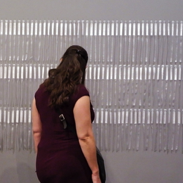Cerebral Entities Series
Cerebral Entities IV
According to the World Health Organization, 1 in every 4 people, or 25% of individuals, develops one or more mental disorders at some stage in life. I ask how have we, the public at large, come to understand mental illness in the 21st century? The formal classification of mental illness began in 1952 with the first edition of the Diagnostic Statistical Manual of Mental Disorders (DSM). It was developed by a committee of psychiatrists to help diagnose WWII veterans and has been revised over the decades. These installations use the DSM-IV published in 1994 and the DSM V published in 2013 to explore the current disorders identified in psychiatry. Each wristband houses a complete, separate diagnosis with its specific code. Each DSM has been created to make a cohesive nomenclature for doctors and clinicians to be able to identify patterns of symptoms. I am curious about the contrast between the understanding of a clinician and the general public. In the last few decades many diagnostic terms have become a part of the larger culture such as Obsessive Complusive Disorder, Attention Deficit Hyperactivity Disorder, and Anorexia. Nervosa. This work aims to make the spectrum of mental disorders visible, to unveil the language of psychiatry, to question how we label individuals, to lift the secrecy, and to bring these disorders out of the shadows of fear and shame. Our ancestors believed that mental illness was caused by the devil or weakness of character. Our understanding of mental illness has evolved to realize it is a complex tangle of genetic, biological and environmental factors. In my work I am drawn to creating order and structure from complex material. There is a vast, opaque expanse to the human condition that we are only on the fringes of understanding.
Cerebral Entities V

